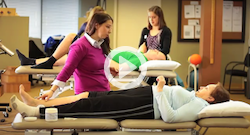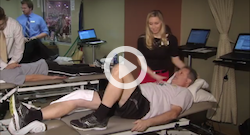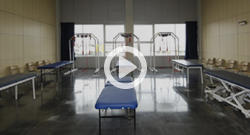What To Expect

You were referred to physical therapy because you need the expertise that only a physical therapist can offer. If you suffer from chronic pain, are recovering from surgery, an accident or debilitating injury physical therapy can help you. You were referred to physical therapy because you need the expertise that only a physical therapist can offer. If you suffer from chronic pain, are recovering from surgery, an accident or debilitating injury physical therapy can help you.
A prescription or referral is not required to see a physical therapist in the state of Virginia for your initial visit. Appointments can be made anytime. However, there are three things to consider based on your situation. First, you can call for a 15-minute free screening. Your therapist will give an examination and tell you if physical therapy is right for you. At that same time, our office staff will let you know if your insurance will cover the treatments. Second, if your health insurance policy requires a referral from your primary care physician for outside services, like physical therapy, request that referral prior to treatment to avoid personal responsibility for incurred charges. Third, if you are receiving physician’s care for the same condition, we will need to notify your primary care physician within 14 days.

The first step to successful rehabilitation and recovery is a complete evaluation. The physical therapist’s evaluation will include an examination of your muscles, test of your joints, and assessment of your injury or condition. At this time education about your condition and an initial plan of care will be given. Next comes hands on manual therapy. A Physical Therapist’s hands can mobilize tissue and joints to allow for a speedier, more complete recovery. You can also expect your therapist to prescribe a personalized exercise regime to be done in the clinic and at home. These exercises will help to restore your strength and function. The key to your complete and sustainable recovery is a team approach: the therapist, the assistant and you.

The body does not change overnight. It can take a number of weeks to stretch, strengthen and retrain. You may need one visit or you may need several months of treatment depending upon your condition. Your physical therapist and your medical doctor will recommend how long you will be treated. Usually, by the second treatment, your physical therapist can give you a good estimate of how many visits it will take to get you back in action.
At the Jackson Clinics we work as a team. You will be evaluated and treated by your physical therapist. Each visit you can expect to receive up to 30 minutes of one-on-one treatment by that therapist. During your treatment sessions you will also see a licensed physical therapist assistant, certified athletic trainer or exercise specialist, primarily to teach and help you perform exercises prescribed by your therapist. Your total treatment time is 75-90 minutes, sometimes longer or shorter based on your individual needs. Remember, we work as a team: therapist, assistant, and you—the patient.

In most cases, health insurance will cover your treatment. The Jackson Clinics makes it easy —we take virtually all insurances with few exceptions. Please make sure to talk to our office manager to help you clarify your insurance coverage.
Please bring your insurance card, driver’s license, the medical doctor’s referral or prescription, your calendar, and payment for your co-pay or deductible. Please download, complete and bring the intake forms found on this site. They can be time consuming, but they are necessary. Please wear comfortable clothing that allows us to expose the body part we are examining. It is best if you bring shorts if we are examining your back or lower extremities. Finally, we ask that you come fifteen minutes early to so the front desk and your therapist can review your paperwork.
Absolutely!! One of our primary responsibilities is to teach you what you need to do at home to manage your condition. And not just at home! Think of how much time you spend at work. Exercise works! Your prescribed home exercises are designed to keep you moving forward.

The Jackson Clinics offers hands on physical therapy, and a highly- skilled manual approach to treating painful tissue and joints. Our approach gets our patients moving faster and ensures a more complete, sustainable recovery. Both the owner and our therapists have a passion for getting the BEST RESULTS for the people we serve! In addition, The Jackson Clinics offers several convenient locations in Northern Virginia. We are locally owned and take virtually all insurances with few exceptions.

If you hurt, we can help. The expertise of a physical therapist can help in many ways. Physical therapists apply research and proven techniques to help effectively prevent and treat a variety of injuries and chronic conditions. Your therapist will educate you about your condition and teach you how to manage and overcome it. A path to your recovery will be skillfully mapped out. Your physical therapist will prescribe exercises that are specific to the nature and severity of your condition. This will help to restore your strength, mobility and relieve pain. Your therapist can help you move forward with your life!
Please wear comfortable clothing that allows us to expose the body part we are examining. It is best if you bring shorts if we are looking at your back or any joint below the back.
We will do everything we can to make your sessions with us pain free. The old adage “no pain, no gain” is ridiculous.
Some insurance contracts require you to pay a certain amount each visit. This amount is called a co-pay. Co-pay amounts can vary depending on your individual policy. Co-pays are expected to be paid on your arrival each visit.
The deductible is the amount you are required to pay before your insurance begins payment. In most cases, when you see practitioners that are “in network”, there is no deductible. Deductibles vary depending on your individual policy. You should check with your insurance company to determine your individual plan coverage. If you have a deductible and have not met it, payment is expected each visit until your deductible is met.
Your responsibility (at the time of service) as determined by certain health insurance plans. Typically a percentage of the charge allowed by your insurance plan (i.e. 10%, 20%).

1940’s: Physical Therapy as a profession really began during World War Two treating causalities of war and expanded into the 50’s treating victims of the polio epidemic. Until 1965 physical therapists earned a certificate in Physical Therapy.
1965: The certificate in physical therapy is phased out. Nationally, a bachelor’s degree is required to sit for licensure examination. The field continued to expand and by 1990 the length of study to complete all of the mandatory courses was at least five years, sometimes longer. In any other field, five years of study would mean the granting of a Masters Degree.
1990: The American Physical Therapy Association (APTA) recommended that universities transition to a Masters level program nationwide. They responded to the call. The transition to a Master’s degree took some years and added even more courses to the field of study. The result was that an individual pursuing a degree in Physical Therapy first spent four years obtaining a bachelor’s degree and then applied to physical therapy school for three more years of study to get a Masters in Physical Therapy (MPT).
2000: Realizing that Masters degrees normally take five years while a Masters in Physical Therapy was taking seven, the APTA again recommended that PT programs expand curriculum further and transition to a higher degree, the Doctor of Physical Therapy, or DPT.
Graduates of PT schools today receive a DPT. They are not medical doctors, who are MD’s. Nonetheless, they carry the title “doctor” by virtue of their educational degree.
It is important to understand that a degree in any field of medicine does not grant the right to practice. A professional must pass State Board examinations to receive a license to practice. At The Jackson Clinics our therapists have a variety of degrees but they have ALL passed their boards and possess a license to practice physical therapy in the State of Virginia.
The Jackson Clinics understands that the field of medicine is exciting and ever changing. For those reasons we aggressively promote continuing education for all of our therapists and assistants. That way we can continue to provide you with the highest quality of care available in this region.
Physical Therapist Assistants work under the supervision of a physical therapist. Their duties include assisting the physical therapist in implementing treatment programs according to the plan of care. They train patients in exercises and activities of daily living, conducting treatments, using special equipment, administering modalities and other treatment procedures, and reporting to the physical therapist on the patient’s response.
Education – PTA’s must complete a 2-year education program, usually offered in a community or junior college. The course of study includes 1 year of general education and 1 year of technical courses on physical therapy procedures and clinical experience Graduates receive an associates degree.
Licensure or registration is required in the state of Virginia to work. Complete information on practice acts and regulations can be obtained from the state licensing boards.
Licensed Certified Athletic Trainer (ATC) – Is a highly educated and skilled professional specializing in athletic health care. In cooperation with physicians, physical therapists and other allied health personnel, the athletic trainer functions as an integral member of the athletic health care team. The ATC is recognized by the American Medical Association as an allied health care professional, and must obtain licensure with the Commonwealth of Virginia Board of medicine prior to practicing athletic training.
Education – ATC’s have, at minimum, a bachelor’s degree, usually in athletic training. Prior to practicing athletic training, one must successfully complete the National Athletic Trainers Association’s Board of Certification (NATABOC) examination.
An Exercise Specialist works under the supervision of a physical therapist. Their duties include assisting the physical therapist in implementing treatment programs according to the plan of care prescribed by the therapist. They train patients in exercises and activities of daily living.
Education – Exercise Specialist have, at a minimum, a bachelor’s degree, usually in exercise physiology or kinesiology.
Each visit will last 75 – 90 minutes on average. Times vary due to the treatment and exercises being performed.
The regularity of your visits will be determined after your initial evaluation, but most patients have 3 visits each week scheduled.
Physical therapists (PTs) and physical therapist assistants (PTAs) are licensed by their respective states.
